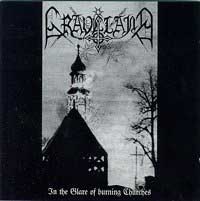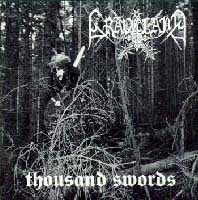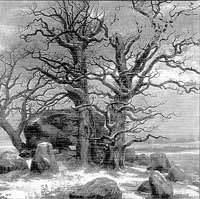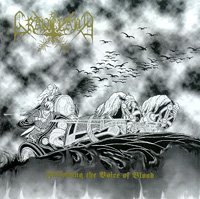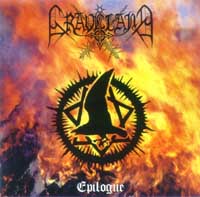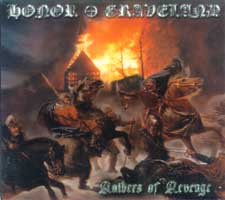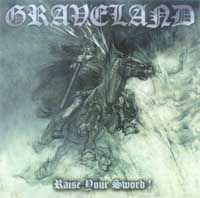Graveland
Graveland - Carpathian Wolves (1994)
Graveland - Thousand Swords (1995)
Graveland - The Celtic Winter (1996)
Graveland - Following the Voice of Blood (1997)
Graveland - Epilogue/In the Glare of Burning Churches (1998)
Graveland - Immortal Pride (1999)
Graveland - Raiders of Revenge (2000)
Graveland - Creed of Iron (2000)
Graveland - Raise Your Sword! (2001)
Graveland - Memory & Destiny (2002)
Production: These demo tapes have been collected on compact disc format and show all of the cheapness and inexperience of that form of medium as well as the deliberate enjoyment of savage distortion and noisy, organic, deconstructed sound.
Review: Underneath the carefully-styled melodic aspirations and chantlike cadences of this music unfurls the hybrid of epic metal and aggressive atonal hardcore that forms the internal pressure in the gently unfolding sound of Graveland. Their unification of simple black metal themes with classical structural principles have enabled this band to hold ground with their long and wandering compositions, dreamlike in their simple melody and poetic recombination.
Tracklist:
1. Intro/In The Glare of Burning Churches (5:12)
2. The Night of Fullmoon (5:03)
3. The dark dusk Abyss (2:19)
4. Through the Occult Veil (4:03)
5. For pagan and heretic's blood (2:44)
6. Instrumental (3:34)
7. Hordes of Empire (4:15)
8. The Gates to the Kingdom of Darkness/Outro (6:17)
Length: 33:32
Raw blasts of sound and stamping rows of chords connect a sequence of moments where the tremelo melody of fast-strummed chords distorted to rampant liquid sound hits its accentuations and leaves floating melody over a sometimes-confused but rhythmically dead-on angry base, giving a haunting nature of uncertainty to the beauty of soaring melodies in power chords harmonized with an open-throated growl of primal pleasure. Hedonistic and retributive, these songs encompass both the free spirit and destructive anger of the feral human soul.
Production: Thick and primitive but enough of a reproduction to add atmosphere and subtract error.
Review: Immense, aspirant, romantic music that flows after melodies and allows itself like a drunken reveler to fade slowly into beautiful hazy afterglow; it is pleased with its own incoherence, and where many albums focus on anger instead points toward a mystical existence of the obscure with its own ambiguity. Basic composition defines this obscurity by creating a few riffs which drift through tones to produce a looping effect, but more by relying on long-phrase melodies to create the structure behind the messy and eclectic riffs.
Tracklist:
1. Carpathian Wolves (intro) (3:35)
2. Barbarism Returns (5:14) 
3. In The Northern Carpathians (1:01)
4. Impaler of Wallachia (5:10)
5. Witches' Holocaust (8:53)
6. At the Pagan Samhain Night (7:38) 
7. Unpunished Herd (8:11) 
8. Into the War (outro) (7:20)
Length: 47:08
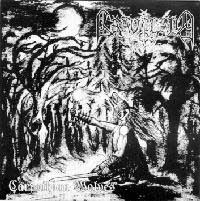
Copyright © 1994 Eternal Devils
Guitars are power chords cruising in a fuzz of smoky static, distortion breaking apart slowly as the soundwaves fall, and are the primary instrument of melody, spelling out in simple notes and chords the passage of harmonic development. Behind them somewhere a rumbling bass, also lost in the raging uncertainty, over marching drums which double beats under the emphasis to create an urgent tempo somewhere between unarmed combat and a graceful, euphonic, unraveling waltz...
With simple but mutating melodies Graveland can exist without ever anchoring themselves to a riff; percussion and melody carry the songs along with so much familiarity that distinctive looping patterns are disadvantageous and riff fragments, leading pieces of scales, interludes of harmonic recursion, and melodic bridging in the style of Emperor work fluently to make each song continuous. Simplicity in guitar playing is exciting here for its innovation; few black metal bands successfully build songs like this.
Distinctive forest beats derive from hardcore rally undulations (pit-speak for the linear repetition of double beats) and the more energetic and throbbing mystical beats from Immortal and Burzum usage building momentum toward a conceptual space of infinite potential. Insane vocals from a distance are overdriven into the striated surge of harmonic noise, chanting each song to conclusion or carrying the texture of the winter wind into a chorus. For its faults and strengths this release as others from this band reveal a distinctive stylistic and ideological persona developing as an idea revealing here its essential passions and tensions in the endless conflict of musical creation.
Production: Distorted backgrounded guitar results in some degradation that often enhances tonal qualities of the music. Crowded and ragged sound gives the album an atmospheric quality of having been recorded in a high school auditorium.
Review: A bizarre fusion of antiquity and noise brings simple melodies interacting in the space of a tempest of distortion, overlapping notes to pollenate each note with the microtones of the notes before and after, giving the listener the ability to understand a continuum of relative overtone.
Graveland play modern black metal with pulsing one-two beats, a derivation of techno, and long sequences of patterning and rhythmic development underneath diffused, distorted, spectral vocals. Yet they unify their songs with a dark and ancient sound, a ritual choreography which emphasizes direct rhythms which change as if seasons, creating an epic story in each song. In this complexity the simple elements are joined by a complex understanding of the evolution of the song, making each position significant in the reduction of mystery to the insignificant.
In other works, this band often sounds like a medieval sacrifical dance, full of resignation, ferocity and beauty. Each song holds together as a self-defining agent of expression; the listeners are rarely left confused but are given some ideas, repeated possibly ineffectively but inoffensively within the context of genre. Relentless drumming tips a high hat to Darkthrone and plays under the melodic noise conflagrations of the guitars, which sound melodic by some method of tuning and are played with heavy repetition of notes to generate a flowing stream of melody. Internal harmonies of the scale come together in this method, revealing a nihilistic simplicity behind the aesthetic of the music.
Long songs move through permutations and repeat themselves reordering each phrase to be repeated and changed in the context of a larger pattern based on the similarity of all pieces. Underlying militaristic tendencies in this music is a vital suppressed rage, a force of survival based in anger and dissonance toward all comfort and social logic. In this environment of the utterly straightforward, beauty emerges in the complex imbalance that drives this voice to speak.
Production: Acerbic and diffuse without being as corrupted and abraded as the most extreme attempts to integrate imperfection of aesthetic as "underground" technique.
Review: The further perfection of the Graveland style of battle metal, The Celtic Winter emerges from fusion of romantic melody and raw black metal in the context of waltzlike, dreamtime music with classical aspirations delivered in microambient doses through its complexity of barren minimalist structure. Fundamental intensity in this music derives from the tension between its melodic progression and its violent, half-dancelike war-step rhythm.
Under roaming organ chords slicing riffs introduce structure and the more unsettling nihilistic melodic motions within codex of possibilities to each song, a structure not unlike the wandering melodies of Emperor that form the spinal foundation of their epic songs. Elemental variations distinguish iterations of idea and hint at where it will attempt to lead; the narrative style similar to this is avoided through fascist tendencies toward repetition of larger structures in order to preserve a simple but unifying melodic coherence. In classic style for this geographical subgenre the vocals are back-of-room distorted shrieks that work less as lead rhythm than as continuance, leading each cycle through a seasonal progression toward death.
Menacing and distorted figures underlie these calmly beautiful riffs; despite the use of strumming as tremelo sustain and consequent lack of distinctive notes in the flow, the handful of notes chosen for each piece represent Burzum-style a sequence of themes and pattern tendencies which describe the poetic world and internal balance of every piece. Beyond the aesthetic fakers who throw folk instruments and scales over droning minor key rock, Graveland have resurrected from past structures and thematic protocols for complex yet simple and atonal compositions, and from that have shown a progression of archaic lawlessness toward the philosophies of future in a collective intellectual space as diffuse, threatening and obscure as the dark music of this ominous voice.
Production: Characteristically distorted production marks this as another Graveland release which incorporates the noise of reality into its diffusion filter, projecting its tones further through their decomposition than in clarity.
Review: Majestic and nihilistic simultaneously this music evolves the romantic saga of the abyss music of Graveland, making from the elements of simplicity a complexity of relationships which suggests paradoxically a world hidden in the very elements of common granularity written off by conventional moralists, scholars, and art critics.
Possibly the most adventurous band in black metal at this time, Graveland have no hesitation about projecting their dissonant and folksy masterpieces at the same time as their fascist views, but did not originate as a political band and allow their primary focus in this music to remain the art behind it. This band interlaces tempos and patterns in a theory of nihilistic motion similar to that of Darkthrone or Burzum, where the chaotic allocation of a centering allows a motion to be created that is more complex than the simple vectors of rock music, preferring a direction of refraction to a teleological need for consistency. The result is ambiguous music that nonetheless clearly enunciates its aspirations toward a more feral and yet more intellectualized reality.
Tracklist:
1. Intro (2:58)
2. White Hand's Pride (8:32)
3. Thurisaz (8:49)
4. Following the Voice of Blood (9:05)
5. Forge of Souls (2:31)
6. Raise the Swords (12:13)
7. And the Horn was Sounding Far Away (11:56)
8. Fed by the Beasts (9:29)
9. Outro (2:34)
Length: 68:11
The formerly solid songs composed primarily of streams of chords in tremelo fluidity have been replaced by slower strumming of more complex note patterns within chords, allowing the open-strum flexibility and familiarity of folk music to merge with the melodic infusion that has been a hallmark of Graveland since their first releases. Melodies which previously stretched like languid felines across all elements of the song now are sublimated between layers of harmonic interchange and rhythmic consistency that seems melodramatic but restrains its theatre to emphasis on the major compositional shifts within each piece.
Sparse yet punctual the drumming of Capricornus once again highlights this album with its unusual understanding of the subdivisions of rhythm inherent in each placement and a post-jazz realization of intermittent patterning as a method of meta-alignment of rhythmic structures within the overall relationship of a piece. Throat searing vocals keep themselves in a narrative function by staying in the rhythmic background while emphasizing the sublime elements of each phrase in harmony and fluid percussion, riding the rhythmic peak rather than hitting it for more effect than the more obvious techniques of precision. Each composition, although built from rudimentary elements seemingly alternating in a cyclic chorus style, has a unique codex to which its riffs and overall structure conforms to accentuate its individuality through which it speaks a poetry of loss and determination.
Production: Demo tape, which with restoration is not far from normal hazy Graveland production.
Review: A very early slice of Graveland is seen here after the widespread confusion over these demos caused the band to relent and put out their second compilation of early recordings, showing the band in 1993 at a primitive state of fusion between hardcore and epic Hammerheart-style melodic but blasting black metal. Similarly vocals emulate the Bathory style in that era, as do patterns of cadence emerging in riff and muscular strumming that is strangely precise for a band this early in its growth, but the first four tracks on this release are unusually feral yet ambitiously majestic in their capture of atmosphere and mood. Drumming is a digital unit but the main attraction is narration and depth in guitars. The technique later to emerge in full usage of harmonizing notes to indicate an internal secondary direction in dissonance is here nascent and powerful, yet understated. These are insights to the working of a great mind.
Tracklist:
From "Epilogue" promo tape:
1. Intro (1:52)
2. The Eyes of Balor (1:22)
3. Shadow of Doom (3:13)
4. The Forest Nemeton (Part two) (4:52)
5. Children of the Moon (5:38)
6. Outro (1:05)
From "In the Glare of Burning Churches" demo:
7. Intro/In the Glare of Burning Churches (4:45)
8. The Night of fullmoon (4:56)
9. The dark dusk Abyss (2:58)
10. Through the occult Veil (3:57)
11. For pagan and heretic's blood (3:33)
Length: 38:13
The remaining half of this album is an alternate version of the "In the Glare of Burning Churches" using a drum machine for some parts of the drumkit, and does not vary a great deal from the other release by this name. To the credit of those who decided to release this session, vocal performance here is at its most hideously distorted and savage, with acidic negative ramifications leaking throughout the areas of implication the tone, texture and shape of lyrical phrasing in hoarse howl touch. The slow assembly of Discharge-styled melodic hardcore into the laconic and dreamlike waltzes of grandeur which were to follow is observable here, giving both sides a fair due in the revelations of ancestry to the majestic black metal to follow. The dual states of the intro and keyboard work on "Through the occult Veil" indicate the talent for ambient music working alongside terrifyingly accurate metal minds.
Review: Honor - Shifting into an eerily Polish black metal mode, riot punk band Honor take their essence and give it the conclusive, infectious phrasing of underground propaganda. At heart a rock/punk band with a heavy metal influence (think the best of AC/DC), Honor pound out cyclic pieces with tightly joined components driving home memes of ethnic and personal pride. Vocals are shouted with the rough timbre of death or black metal vocalization barely inflected in each pronunciation, and drumming is an outline of rock/punk high energy/low complexity styling. While this may grow on the nerves of some, it is reasonable for what it attempts to be. An anthemic and proud five tracks portray a call of pagan values as immanent to self-respect.
Tracklist:
Honor:
1. Antichrist's Hammer (6:03)
2. Wrath (6:25)
3. Invaders (5:54)
4. Thousand years bonds (4:32)
Graveland:
5. Blacksmiths of Destiny (7:44)
6. Source of My Power (8:07)
7. Into Death's Arms (9:19)
Length: 48:08
Graveland - Caught between developing the majestic soundtrack of Lord Wind and creating the ambient mideval metal of Graveland, the creative forces behind this band have emerged with a brilliant fusion, using all of the orchestration of Impaler's Wolves and the offhand tightness of Creed of Iron to make four tracks of expansive and dynamic black metal. These use the shorter riffing of recent full lengths from this band but invoke, in a style reminiscent of Lord Wind, longer melodies with a greater attention to tonal and rhythmic shape in melding multiple themes into a coherent narrative. The result sounds halfway to ambient music but maintains the powerful and literal elocution of metal.
Production: Clean and well integrated.
Review: With an EP of two new songs and a Polish version of a reworked older tune, Graveland move forward in the epic soundtrack of longer melodies style that has become a dominant influence from Lord Wind, but do so in the freely flowing and potently simple melodies which exhalted "Thousand Swords" to its revered status. Of coalescing scenery which subtly becomes evident within the swarming sounds of keyboards, guitar fuzz and vocals in interwoven liquid state, this band mould adventures in which feral battlelust alone determines who survives.
Tracklist:
1. Till the final Death (9:51)
2. Temple of My hatred (10:15)
3. W Ojecia Smierci (9:18)
Length: 29:27
Gullwinged note progressions liltingly drift above precise and unobtrusive percussion while keyboards surround from below and inundate as guitar, in a upsweep of refined black metal heritage, invokes a new note cluster to change tonal center and mood. The strength of this band in making four-note melodies and their complementary halves, as applied to songs that alternatingly rip and waltz, sustains the resonant qualities of sound manipulated in each piece. While bass and guitar have the shelf-ready composure and precision that marks "Creed of Iron," careful use of dissonant chord voicing and strumming technique thrusts listener expectation toward a longer frame of reference.
Hypnotic in pulsating transitions of tone the dominant themes expressed throughout this work emphasize motion and harmonies in unbalanced and unsymmetrical, unpeaceful figures. Motifs work within a cluster of concepts making each song distinct and Graveland ensure that at least two highly memorable riff constructions unite individual works. A studied creation of melody renders multiple directions in potential within a simple circular interruption of symmetry, allowing tendrils of awareness to drift in other directions which then must return to the central theme or dominate it.
In the same way that "Thousand Swords" levelled audiences with its assertive embrace of medieval ethos in music, the newer material from Graveland overcomes the tendency toward consistency that form-stamped "Creed of Iron" and gestures a future direction for this band. The reworked older song accrues more grace of presentation and an added ferocity in Polish, yet this EP can grasp the intuitive unconscious mind of a listener within the first two tracks and leave them with a sense of loss when it ends.
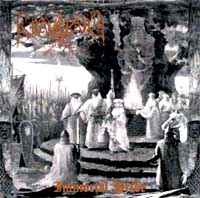
1. Intro (Day of fury) (3:21)
2. Songs of fire and steel/Outro (Servants of war) (23:39)
3. Sacrifice for honour (16:24)
4. Outro (To die in glory) (7:00)
Length: 50:25
Immortal Pride (No Colours 1999)
With more open phrases supporting the motion of vocals and rhythm over predetermined shape of song structure, Immortal Pride uses longer songs and layered repetition and deconstruction of melody to produce a thematic sense that is far beyond rock, yet lacks much of the passion of the original Graveland releases and focuses more on building a solid foundation of understanding and association with ancient heathen melody. While this is achieved, earlier works are a better vision of the artistic soul of this groundbreaking band.
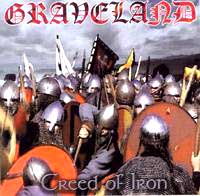
1. Blood and Ash (2:34)
2. Tyrants of Cruelty (10:19)
3. No mercy in my Heart (9:29)
4. Ancient Blood (11:18)
5. White Beasts of Wotan (10:44)
Length: 44:27
Creed of Iron (No Colours, 2000)
The most polished and instrumentally precise Graveland album ever, this work takes the more listener-friendly open phrasing of Immortal Pride and adapts it to long and easily tolerated songs combining fluid basic guitar with keyboards and voice repeating melodies in the style shown on Lord Wind and innumerable intros: layers, themes, conflicts, breakdowns, repetitions, introductions, transitions and then rising chorus of four or six notes rocketing tonal expectancy through the scale with the dynamic yet even motion of punk rock based on the scalar formation of power chords on guitar. The "epic" nature of themes is still here but is less believable; this is Graveland at their most accessible yet with their most granular focus, breaking down some of the larger atmosphere once manipulated by this band. Ear-friendly and even reasonably consonant this release will go far but is distant from the core of this band.
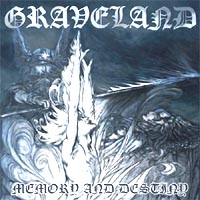
Tracklist
1. Fate Of Warrior (8:49)
2. Jewel Of Atlanteans (9:44)
3. Memory And Destiny (10:17)
4. Legion Of Giants (9:35)
5. Runes Of Rise (9:37)
Length: 48:07
Memory & Destiny (No Colours, 2002)
Crafting in the new style something reminiscent of older Graveland merged with more recent Lord Wind releases, this longstanding blackmetal outfit use the appearance of Creed of Iron - balanced guitars, home studio sequencing and keyboards, percussion that now does not sound backward to drummers - for an epic on the level of the works of Summoning or Burzum in its gently inductive melodic logic. While it is easier listening because of the refined production and efficient songwriting, the raw spirit that made this music once violent now makes it contemplative, broadreaching and vastly perceptive of the sounds and patterns that stimulate the human spirit. Arcing melodies radiate above simple/rock metal drumbeats and keyboards shadow the fuzztone guitars, creating a sea of harmony into which the waves of sound return. Darken's vocals are subdued, announcing in a black metal voice the lyrics which hold place in each song, capturing some melody but mostly an abstract and distant rhythmic positioning. Song structures are extensively customized variants of the theme/motif juggling common to classical-inspired soundtracks. While for much of the black metal crowd this may have drifted too far into the Summoning and Abigor school of slick melodic soundscapes, underneath its shiny exterior there is a ferality devoutly opposed to the valueless plastic of our time.
